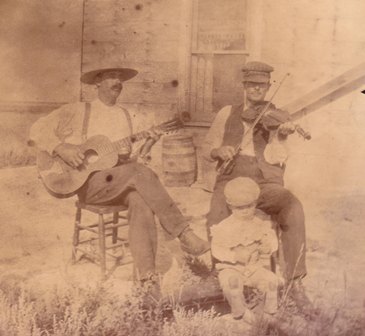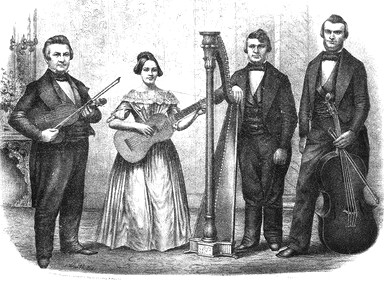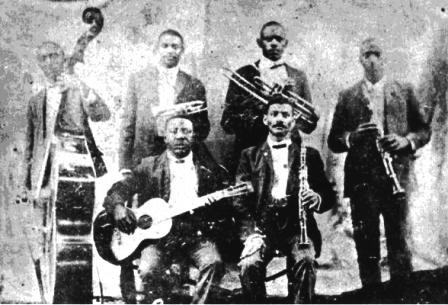 Modern country music, rock & roll and R&B are the progeny of early twentieth century hillbilly music and the blues. The central role of the guitar in those earlier genres helped to drive the instrument to unprecedented heights of popularity in the twentieth and twenty-first centuries. But nearly a century before the first recordings of blues and hillbilly guitarists, the instrument already had seized the imagination of American musicians. Sparked by the popularity of several Spanish and Italian virtuosos, a craze for the six-string “Spanish” guitar swept Europe in the 1810s and reached America around 1830. Over the course of the nineteenth century, the instrument became an integral part of new styles of distinctively American music. By the turn of the twentieth century, almost all the elements were in place for the chain reaction that would propel the guitar to a nearly unassailable position as the dominant instrument of American popular music.
Modern country music, rock & roll and R&B are the progeny of early twentieth century hillbilly music and the blues. The central role of the guitar in those earlier genres helped to drive the instrument to unprecedented heights of popularity in the twentieth and twenty-first centuries. But nearly a century before the first recordings of blues and hillbilly guitarists, the instrument already had seized the imagination of American musicians. Sparked by the popularity of several Spanish and Italian virtuosos, a craze for the six-string “Spanish” guitar swept Europe in the 1810s and reached America around 1830. Over the course of the nineteenth century, the instrument became an integral part of new styles of distinctively American music. By the turn of the twentieth century, almost all the elements were in place for the chain reaction that would propel the guitar to a nearly unassailable position as the dominant instrument of American popular music.
Because it is so closely associated with rural blues and hillbilly music in the popular imagination, the acoustic guitar is often thought of as fundamentally a folk instrument. Antebellum guitarists, however, valued the instrument because of its ties to the refined musical heritage of Europe. In the 1830s Americans still looked to London for the latest in cultural fashion, and eagerly adopted an English fad for the guitar. The most popular professional guitarists in America during the 1830s and 1840s, such as G.E. Bini, John Coupa and Dolores Nevares de Goni, were European musicians performing in the prevailing European style (but with repertoires sprinkled with American favorites like “Yankee Doodle” and the minstrel show hit “Lucy Long.”)
Over time, the guitar shed its European accent and was assimilated within new types of uniquely American popular music. Far from being the rural styles typically associated with American “roots” music, these early manifestations of American popular music emerged in the cities, and the guitarists that contributed to their birth and growth typically were sophisticated urban musicians. Rural songsters and string band members, the types of musicians most often associated with the history of the American guitar, largely ignored the instrument until about the turn of the twentieth century.
 As early as the late 1840s the guitar provided accompaniment for singing groups such as the Barker Family, the Gibson Family, and the most popular of the many vocal groups of the era, the Hutchinson Family. These groups represented “something original and beautiful in the way of American musical execution,” according to Walt Whitman. By the 1850s, guitarists were featured with many leading blackface minstrel troupes. The minstrel show was the most popular form of entertainment in nineteenth century America and the first commercial genre to attempt the fusion of African and European musical elements that has characterized American music to the present day. Urban African-American musicians took up the instrument in the decades following the Civil War, incorporating it in “jig bands” that were the predecessors of ragtime and jazz ensembles.
As early as the late 1840s the guitar provided accompaniment for singing groups such as the Barker Family, the Gibson Family, and the most popular of the many vocal groups of the era, the Hutchinson Family. These groups represented “something original and beautiful in the way of American musical execution,” according to Walt Whitman. By the 1850s, guitarists were featured with many leading blackface minstrel troupes. The minstrel show was the most popular form of entertainment in nineteenth century America and the first commercial genre to attempt the fusion of African and European musical elements that has characterized American music to the present day. Urban African-American musicians took up the instrument in the decades following the Civil War, incorporating it in “jig bands” that were the predecessors of ragtime and jazz ensembles.
 While some guitarists diligently studied the instrument with teachers trained in the European tradition, many others were content to learn just enough chords to accompany the simple popular songs of the day. Typically these musicians “caught” tunes – that is to say, they sang and played “by ear,” and often improvised a strummed or arpeggiated chordal accompaniment. Trained musicians were contemptuous of these unschooled guitarists, but nineteenth century guitarists’ grounding in chords played a vital role in the evolution of modern American styles of music. Chord-strumming guitarists were the foundation of what evolved into the rhythm section of the earliest jazz bands. The guitarist’s backdrop of block chords provided a solid platform for improvisation by the “front line” of horns. The rhythm section concept was later adopted by country and rhythm & blues bands, and has remained the core of American popular music ensembles to the present day.
While some guitarists diligently studied the instrument with teachers trained in the European tradition, many others were content to learn just enough chords to accompany the simple popular songs of the day. Typically these musicians “caught” tunes – that is to say, they sang and played “by ear,” and often improvised a strummed or arpeggiated chordal accompaniment. Trained musicians were contemptuous of these unschooled guitarists, but nineteenth century guitarists’ grounding in chords played a vital role in the evolution of modern American styles of music. Chord-strumming guitarists were the foundation of what evolved into the rhythm section of the earliest jazz bands. The guitarist’s backdrop of block chords provided a solid platform for improvisation by the “front line” of horns. The rhythm section concept was later adopted by country and rhythm & blues bands, and has remained the core of American popular music ensembles to the present day.
Guitar makers and performers constantly tinkered with the physical characteristics of the instrument to meet the demands of new styles of music and new performance challenges. Over the course of the nineteenth century, the guitar shed many of its most European characteristics, and instruments with decidedly American features emerged. Christian Frederick Martin is often credited with being the American guitar maker that first broke away from the European mold to build instruments to appeal to American tastes. Martin was certainly the most important American guitar maker of the nineteenth century, but his reputation as an innovator is probably exaggerated: many of his lesser known contemporaries were building guitars along similar lines. An enormous amount of creative energy was devoted to solving the volume problem: the small gut-strung guitar of the era simply was not loud enough to fill an auditorium or hold its own in an ensemble of louder instruments. One solution was to build larger instruments, and Dreadnought size guitars – a development that often is considered a twentieth century innovation – were being marketed by some manufacturers by the 1890s.
Perhaps the most transformational event in American guitar technology during the nineteenth century was the widespread adoption of steel strings in the 1880s, followed in the 1890s by guitars built specifically to withstand the stress of high-tension strings. Steel strings were not only better suited for many types of ensemble playing where the guitar competed with instruments such as the then-popular mandolin, they also opened the door to entirely new performance practices. The brighter sound and much greater sustain made them far more effective than gut strings for Hawaiian-style steel guitar and African-American bottleneck style playing, both of which emerged before the turn of the twentieth century. Perhaps most significantly, the higher tension of steel strings better enabled guitarists to “bend” the strings to expressively reach tones that fall between the steps of the Western chromatic scale. This technique was first developed into a cohesive performance style by African-American musicians as a new type of music that would become known as the blues took shape in the late nineteenth and early twentieth centuries.
The guitar entered the twentieth century as the instrument that would define the future of American popular music (though musicians of the time were utterly unaware of that fact). Steel string instruments were well established, along with new playing techniques that would characterize blues and country guitar performance styles. The earliest jazz bands were incorporating the guitar in what would become one of the signature features of jazz, country, R&B and rock & roll, the rhythm section. Itinerant African-American songsters had enthusiastically embraced the instrument, paving the way for the highly influential generation of blues musicians that first recorded in the 1920s. Rural white musicians were beginning to use the guitar in the type of hillbilly string ensemble that later would evolve into modern country and rock & roll bands.
The explosion of recordings of blues and hillbilly musicians in the 1920s, the result of an almost accidental discovery by record company executives that there were untapped markets among African-Americans and rural whites, seems like the Big Bang of American popular music. Guitarists and fans of popular music are understandably left with the impression that these recordings capture long-standing rural performance traditions and represent the origins of the guitar in American music. In reality, the story of the guitar in the birth and growth of American popular music played out in minstrel shows, on vaudeville stages and in urban juke joints over the course of the nineteenth century. Rather than reflections of ancient rural guitar traditions, the earliest recordings of hillbilly music and the blues represented comparatively new developments that were deeply indebted to earlier urban music styles and guitar performance practices.
David K. Bradford
http://www.19thcenturyguitar.com
Illustrations: Frontier musicians, The Gibson Troupe, Buddy Bolden’s Band c.1905




